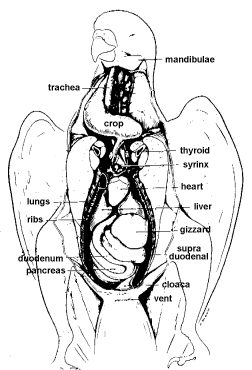Crop Stasis
 Crop stasis occurs when the normal mobility of the crop is impaired, causing food to remain in the crop. The crop may appear enlarged orit may be hidden by feathers. Food, fluid and mucus or foreign bodies may be present in the crop. Crop stasis is most common in baby psittaciines (parrots) and may be the result of improper concentration of formula, infection or dehydration. In older birds crop stasis may result from lead or zinc intoxication, foreign bodies, candida, parasites or viral infections, including PDD. Whatever the cause, food that remains in the crop for prolonged periods of time spoils as a result of bacterial and fungal overgrowth and can lead to systemic illness. Veterinary care consists of determining and treating the cause of the stasis, removing the crop contents, lavaging (washing) the crop and restoring its normal motility.
Crop stasis occurs when the normal mobility of the crop is impaired, causing food to remain in the crop. The crop may appear enlarged orit may be hidden by feathers. Food, fluid and mucus or foreign bodies may be present in the crop. Crop stasis is most common in baby psittaciines (parrots) and may be the result of improper concentration of formula, infection or dehydration. In older birds crop stasis may result from lead or zinc intoxication, foreign bodies, candida, parasites or viral infections, including PDD. Whatever the cause, food that remains in the crop for prolonged periods of time spoils as a result of bacterial and fungal overgrowth and can lead to systemic illness. Veterinary care consists of determining and treating the cause of the stasis, removing the crop contents, lavaging (washing) the crop and restoring its normal motility.
Crop Burns
Crop burns occur when birds ingest food that is too hot. This is seen most commonly in baby birds that are fed formula that has been microwaved and not mixed thoroughly, leaving hot spots in the food. If the burn is mild, swelling and reddness will appear on the surface of the skin within several days. If the burn is severe, a hole or fistula develops, resulting in the formula or food leaking onto the neck. Severe burns require surgical repair. If a burn is suspected, the bird should be examined by a veterinarian to assess the extent f the burn and what treatment is necessary. Crop burns should not be ignored and can be potentially life threatening. The type of treatment depends upon the degree of tissue damage. Mild burns may be treated with antibiotics and topical ointments, while sever burns may require surgical repair.
Regurgitation
Regurgitation is the ejection of food from the crop. Regurgitation differs from vomiting, which is the ejection of food from the proventriculus (glandular stomach) and the ventriculus ( muscular stomach or gizzard). If the ejected food looks like it is partially digested, then it is most likely that it is coming from lower down in the digestive tract and is vomiting. Regurgitated food appears undigested.
Regurgitation may be normal or it may signal crop or systemic disease. Some birds will regurgitate to another bird or their owners or toys as a sign of affection and courtship. Other birds may regurgitate from excitement, fear or traveling. Certain species – such as pigeons and doves – will regurgitate a secretion known as “crop milk” to their young. Crop stasis, foregn bodies, certain parasites, bacterial infections, viral infections, Candidiasis, certain oral antibiotics, and lead or zinc intoxication may also result in regurgitation.
A dysfunction of the proventriculus and ventriculus may also lead to regurgitation and vomiting. This dysfunction may be caused by many of the things that can adversely affect the crop.
Liver disease, kidney disease, pancreatic disease and reproductive tract disease may also cause regurgitation, vomiting and loss of appetite.
Because so many things can cause disorders of the gastrointestinal tract, the ailing avian patient should be given a thorough evaluation, consisting of a physical examination, blood workup, cultures, fecal examination. Radiographs may be necessary to completely evaluate the digestive tract. Supportive care consisting of fluids, antibiotics, antifungals, and antiemetics is often necessary.
Other articles by Linda Pesek DVM on the digestive tract and its disorders can be found at:
The Avian Digestive Tract
Disorders Of The Upper Digestive Tract

